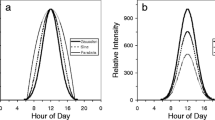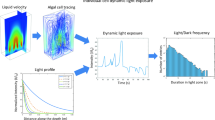Abstract
Light penetration depth in high-densityChlorella cultures can be successfully estimated by Beer-Lambert's law. The efficiency of light energy absorption by algal cultures was so high that algal cells near the illuminating surface shade the cells deep in the culture. To exploit the potential of high-density algal cultures, this mutual shading should be eliminated or minimized. However, providing more light energy will not ease the situation and it will simply drop the overall light utilization efficiency.
Similar content being viewed by others
References
Rabinowitch, E. (1961) Spectral efficiency of photosynthesis, p. 274–298. In: Campbell, P. A. (ed.),Medical and Biological Aspects of the Energies of Space. Columbia University Press. New York, NY.
Krauss, R. W. and A. Osretkar (1961)Minimum and maximum tolerances of algae to temperature and light intensity. Columbia University Press. New York, NY.
Thacker, D. R. and H. Babcock (1957) The mass culture of algae.J. Sol. Energy Science. Eng. 1: 37–49.
Kyle, D. J., C. B. Osmond, and C. J. Arntzen (1987)Photoinhibition. Elsevier. Amsterdam, Netherlands.
Lee, C.-G. and B. O. Palsson (1994) High-density algal photobioreactors using light-emitting diodes.Biotechnol. Bioeng. 44: 1161–1167.
Vonshak, A. (1986) Laboratory techniques for the cultivation of microalgae, p. 117–145. In: Richmond, A. (ed),Handbook of Microalgal Mass Culture, CRC Press. Boca Raton, FL, USA.
Lee, C.-G. and B. O. Palsson (1996) Photoacclimation ofChlorella vulgaris to red light from light-emitting diodes leads to autospore release following each cellular division.Bioechnol. Prog. 12: 249–256.
Emerson, R. and C. M. Lewis (1943) The dependence of quantum yield ofChlorella photosynthesis on wave length of light.Amer. J. Bot. 30: 165–178.
Kok, B. (1960) Efficiency of photosynthesis., p. 566–633. In: Ruhland, W. (ed.),Encyclopedia of Plant Physiology, Springer, Berlin, Germany.
Myers, J. (1980) On the algae: thoughts about physiology and measurements of efficiency., p. 1–16. In: Falkowski, P. G. (ed.),Primary Productivity in the Sea. Plenum Press, New York, NY.
Pirt, S. J., Y.-K. Lee, A. Richmond, and M. W. Pirt (1980) The photosynthetic efficiency ofChlorella biomass growth with reference to solar energy utilization.J. Chem. Tech. Biotechnol. 30: 25–34.
Richmond, A. (1986) Outdoor mass cultures of microalgae, p. 285–330. In: Richmond, A. (ed.)Handbook of Microalgal Mass Culture. CRC Press, Boca Raton, FL.
Van de Hulst, H. C. (1957)Light scattering by small particles, John Wiley, New York, NY
Aiba, S. (1982) Growth kinetics of photosynthetic microorganisms, p. 85–156. In: Fiechter A. (ed.)Adv. Biochem. Eng., Vol. 23, Microbial Reactions. Springer-Verlag, Berlin, Germany.
Cornet, J. F., C. G. Dussap, and G. Dubertret (1992) A structured model for simulation of cultures of the cyanobacteriumSpirulina platensis in photobioreactors: I. Coupling between light transfer and growth kinetics.Biotechnol. Bioeng. 38: 817–882.
Cornet, J. F., C. G. Dussap, P. Cluzel, and G. Dubertret (1992) A structured model for simulation of cultures of the cyanobacteriumSpirulina platensis in photobioreactors: II. Identification of kinetic parameters under light and mineral limitations.Biotechnol. Bioeng. 38: 826–834.
Frohlich, B. T., I. A. Webster, M. M. Ataai, and M. L. Shuler (1983) Photobioreactors: models for interaction of light intensity, reactor design, and algal physiology.Biotechnol. Bioeng. Symp. 13: 331–350.
Geider, R. J. and B. A. Osborne (1992) Light utilization and optical properties of algae, p. 122–155. In: Geider, R. J. and M. Melkonian (eds.), Current Physiology,Algal Photosynthesis. Chapman and Hal. New York, NY.
Morel, A. and A. Bricaud (1981) Theoretical results concerning light absorption in a discrete nedium, and application to specific absorption of phytoplankton.Deep-Sea Research 28A: 1375–1393.
Geider R. J. and B. A. Osborne (1987) Light absorption by a marine diatom: experimental observation and theoretical calculations of the package effect in a smallThalassiosira species.Mar. Biol. 96: 299–308.
Duysens, L. N. M. (1956) The flattening of the absorption spectrum of suspensions, as compared to that of solutions.Biochem. Biophys. Acta 19: 1–12.
Author information
Authors and Affiliations
Corresponding author
Rights and permissions
About this article
Cite this article
Lee, CG. Calculation of light penetration depth in photobioreactors. Biotechnol. Bioprocess Eng. 4, 78–81 (1999). https://doi.org/10.1007/BF02931920
Issue Date:
DOI: https://doi.org/10.1007/BF02931920




